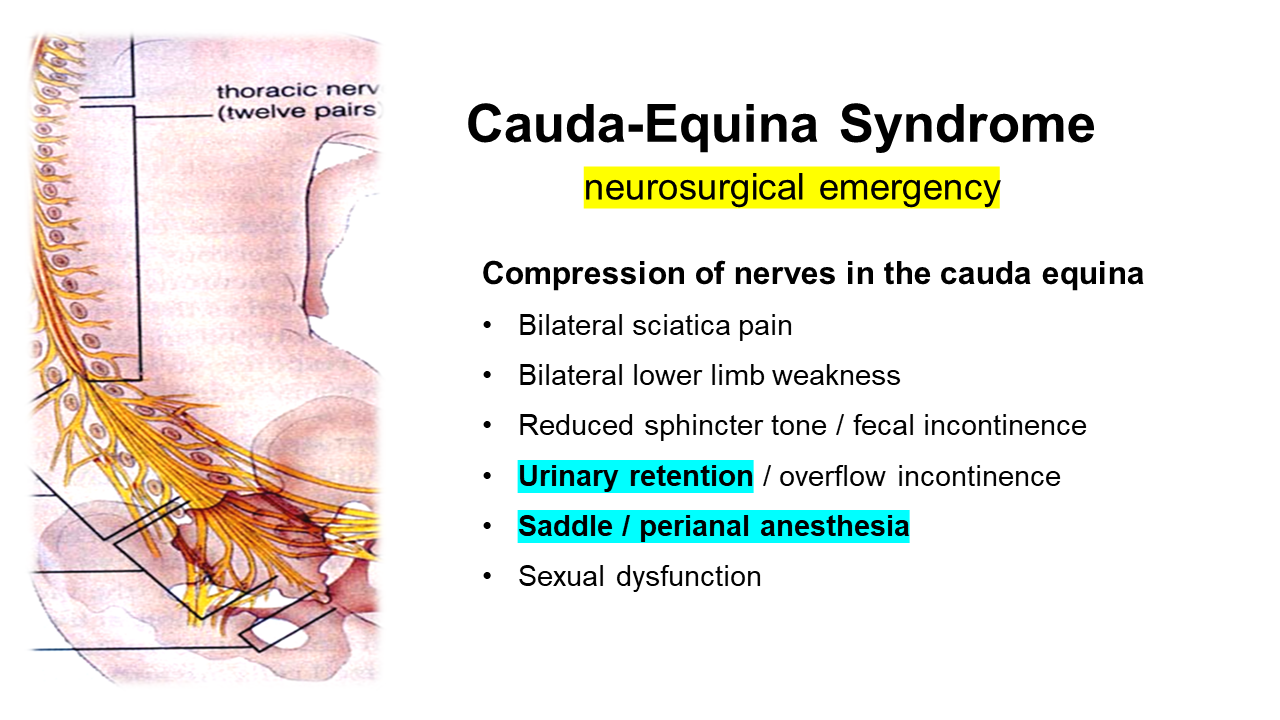Cauda Equina Syndrome (CES)

Cauda Equina Syndrome (CES): Overview, Symptoms, Causes, and Treatment
What is Cauda Equina Syndrome?
Cauda Equina Syndrome (CES) is a serious neurological condition caused by compression or damage to the bundle of nerve roots at the lower end of the spinal cord called the cauda equina. This nerve bundle transmits messages to and from the lower limbs, bladder, bowel, and pelvic organs. Compression leads to disruption of motor and sensory functions, making CES a medical emergency requiring prompt diagnosis and treatment.
Symptoms
Symptoms of CES can develop suddenly or gradually and often include:
- Severe lower back pain and sciatica (radiating leg pain).
- Saddle anesthesia: numbness or loss of sensation in areas that would contact a saddle, including inner thighs, buttocks, and perineum.
- Bladder and bowel dysfunction such as urinary retention, incontinence, and difficulty controlling bowel movements.
- Lower limb weakness, numbness, or paralysis, often with loss of reflexes (e.g., absent ankle jerk).
- Sexual dysfunction due to nerve impairment.
- Gait disturbances or difficulty walking.
Causes
CES is most commonly caused by:
- Herniated lumbar disc compressing nerve roots.
- Lumbar spinal stenosis (narrowing of spinal canal).
- Spinal tumors.
- Infections such as epidural abscess.
- Trauma or fractures to the lumbar spine.
- Other causes include epidural hematoma and inflammation.
Diagnosis
CES diagnosis is clinical supported by urgent imaging studies, primarily magnetic resonance imaging (MRI) to identify nerve compression. Early recognition of red flag symptoms such as saddle anesthesia and bladder dysfunction is critical for timely intervention.
Treatment
CES is a surgical emergency requiring prompt decompression to relieve nerve root pressure:
- Decompression surgery such as laminectomy or discectomy aims to restore nerve function.
- Surgery ideally performed within 24-48 hours improves chances for recovery and reduces permanent disability.
- Postoperative rehabilitation includes physical therapy and symptom management.
Delayed treatment risks permanent paralysis, loss of bladder/bowel control, and chronic pain.
Key Points
- CES results from compression of nerve roots below the spinal cord.
- Presents with severe back pain, saddle anesthesia, bladder and bowel dysfunction, leg weakness.
- Causes include herniated discs, spinal stenosis, tumors, infections, and trauma.
- Emergency surgery to relieve pressure is essential to prevent permanent damage.
- Early diagnosis and treatment yield better functional outcomes.
Consult with Our Team of Experts Now!
If you or someone you know experiences symptoms suggestive of CES, seek immediate medical attention. Our expert spine team provides rapid diagnosis, surgical treatment, and comprehensive supportive care using Cellular Therapy and Stem Cells.
References:
Mustafa MA, Wrong O, Darby CE, et al. Definition and surgical timing in cauda equina syndrome—A systematic review. PLoS One. 2023 May 3;18(5):e0285006. doi:10.1371/journal.pone.0285006. Available at: https://journals.plos.org/plosone/article?id=10.1371/journal.pone.0285006















